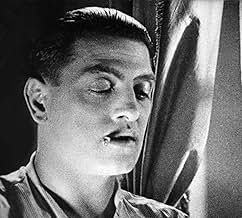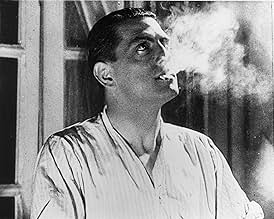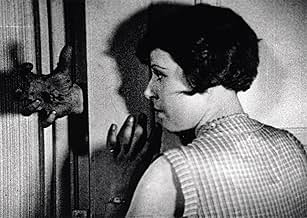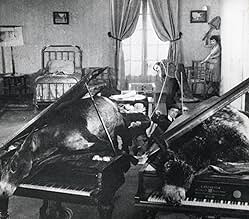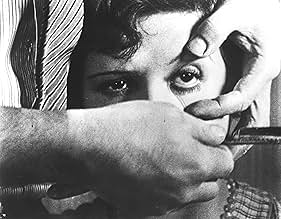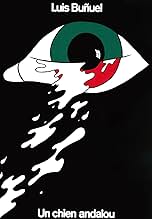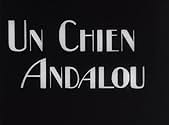Un chien andalou
IMDb RATING
7.6/10
56K
YOUR RATING
Luis Buñuel and Salvador Dalí present 16 minutes of bizarre, surreal imagery.Luis Buñuel and Salvador Dalí present 16 minutes of bizarre, surreal imagery.Luis Buñuel and Salvador Dalí present 16 minutes of bizarre, surreal imagery.
Pierre Batcheff
- Man
- (as Pierre Batchef)
Simone Mareuil
- Young Girl
- (as Simonne Mareuil)
Luis Buñuel
- Man in Prologue
- (uncredited)
Pancho Cossío
- Stroller
- (uncredited)
Salvador Dalí
- Seminarist
- (uncredited)
Juan Esplandiu
- Stroller
- (uncredited)
Robert Hommet
- Young Man
- (uncredited)
Marval
- Seminarist
- (uncredited)
Fano Messan
- Hermaphrodite
- (uncredited)
Jaume Miravitlles
- Fat Seminarist
- (uncredited)
- Director
- Writers
- All cast & crew
- Production, box office & more at IMDbPro
Featured reviews
This famous film starts in a dream-like sequence, a woman's eye (a cow's eye was actually used) is slit open and juxtaposed with a similarly shaped cloud obscuring . After that , there take place several bizarre events such as a man has a hole in the palm from which ants emerge , it is shown literally ; later on , a man pulls a piano along with the tablets of the Ten Commandments and a dead donkey and two priests being dragged with the piano (a priest is Salvador Dalí) ; a woman pokes at a severed hand in the street with his cane (legend has it that the severed hand used in the street scene was a real hand, and Dali convinced a man to cut it off in exchange for enough money to buy lunch) , among others .
Abstract film that marked strong polemic in the epoch when it was realised , especially its sliced eyeball at the beginning , and still packs a punch even nowadays . In fact , at the Paris premiere, Luis Buñuel hid behind the screen with stones in his pockets for fear of being attacked by the confused audience . After editing the feature , Luis Buñuel and Salvador Dalí didn't know what to do with it , as an acquaintance introduced Buñuel to Man Ray, who had just finished Les Mystères du château Dé and was looking for a second film to complete the program , the two movies premiered together at the Studio Ursulines ; it made a deep impression on the Surrealist Group, who welcomed Buñuel into their ranks . The movie contains several references to Federico García Lorca and other writers of that time . The rotting donkeys are a reference to the novel "Platero y yo" by Juan Ramón Jiménez, which Luis Buñuel and Dalí hated . In 1960, a soundtrack was added to this film at the direction of Luis Buñuel , he used the same music which was played , using phonograph records , at the 1929 screenings-extracts from "Liebestod" from Richard Wagner's "Tristan and Isolde" and two Argentinian tangos.
This rare short belongs to Luis Buñuel's first period and has been voted as one of "The 25 Most Dangerous Movies" . After moving to Paris , Buñuel did a variety of film-related odd jobs , including working as an assistant to director Jean Epstein . With financial help from his mother and creative assistance from Dalí, he made his first film , this 17-minute "Un Chien Andalou" (1929), and immediately catapulted himself into film history thanks to its disturbing images and surrealist plot . The following year , sponsored by wealthy art patrons, he made his first picture , the scabrous witty and violent "Age of Gold" (1930), which mercilessly attacked the church and the middle classes, themes that would preoccupy Buñuel for the rest of his career . That career, though, seemed almost over by the mid-1930s, as he found work increasingly hard to come by and after the Spanish Civil War , where he made ¨Las Hurdes¨ , as Luis emigrated to the US where he worked for the Museum of Modern Art and as a film dubber for Warner Bros . He subsequently went on his Mexican period with "The Great Madcap" , ¨Los Olvidados¨ , ¨The brute¨, "Wuthering Heights", ¨El¨ , "The Criminal Life of Archibaldo De la Cruz" , ¨Robinson Crusoe¨ and many others . And finally his French-Spanish period with notorious as well as polemic films such as ¨Viridiana¨ , Tristana¨ , ¨The Discreet Charm of the Bourgeoisie" and his last picture , "That Obscure Object of Desire" .
Abstract film that marked strong polemic in the epoch when it was realised , especially its sliced eyeball at the beginning , and still packs a punch even nowadays . In fact , at the Paris premiere, Luis Buñuel hid behind the screen with stones in his pockets for fear of being attacked by the confused audience . After editing the feature , Luis Buñuel and Salvador Dalí didn't know what to do with it , as an acquaintance introduced Buñuel to Man Ray, who had just finished Les Mystères du château Dé and was looking for a second film to complete the program , the two movies premiered together at the Studio Ursulines ; it made a deep impression on the Surrealist Group, who welcomed Buñuel into their ranks . The movie contains several references to Federico García Lorca and other writers of that time . The rotting donkeys are a reference to the novel "Platero y yo" by Juan Ramón Jiménez, which Luis Buñuel and Dalí hated . In 1960, a soundtrack was added to this film at the direction of Luis Buñuel , he used the same music which was played , using phonograph records , at the 1929 screenings-extracts from "Liebestod" from Richard Wagner's "Tristan and Isolde" and two Argentinian tangos.
This rare short belongs to Luis Buñuel's first period and has been voted as one of "The 25 Most Dangerous Movies" . After moving to Paris , Buñuel did a variety of film-related odd jobs , including working as an assistant to director Jean Epstein . With financial help from his mother and creative assistance from Dalí, he made his first film , this 17-minute "Un Chien Andalou" (1929), and immediately catapulted himself into film history thanks to its disturbing images and surrealist plot . The following year , sponsored by wealthy art patrons, he made his first picture , the scabrous witty and violent "Age of Gold" (1930), which mercilessly attacked the church and the middle classes, themes that would preoccupy Buñuel for the rest of his career . That career, though, seemed almost over by the mid-1930s, as he found work increasingly hard to come by and after the Spanish Civil War , where he made ¨Las Hurdes¨ , as Luis emigrated to the US where he worked for the Museum of Modern Art and as a film dubber for Warner Bros . He subsequently went on his Mexican period with "The Great Madcap" , ¨Los Olvidados¨ , ¨The brute¨, "Wuthering Heights", ¨El¨ , "The Criminal Life of Archibaldo De la Cruz" , ¨Robinson Crusoe¨ and many others . And finally his French-Spanish period with notorious as well as polemic films such as ¨Viridiana¨ , Tristana¨ , ¨The Discreet Charm of the Bourgeoisie" and his last picture , "That Obscure Object of Desire" .
"Sitting comfortably in a dark room, dazzled by the light and the movement which exert a quasi-hypnotic power... fascinated by the interest of human faces and the rapid changes of place, [a] cultivated individual placidly accepts the most appalling themes...and all this naturally sanctioned by habitual morality, government, and international censorship, religion, dominated by good taste and enlivened by white humor and other prosaic imperatives of reality." - Luis Bunuel
Un Chien Andalou exists to shock the viewer of this stupor that Bunuel elucidates above. Freudian dream imagery, amorphous space/time, and absurdist humor combine in this drawn out mating ritual between a confused cyclist and the female he pursues. May be the most inventive fifteen minutes of film anywhere.
Un Chien Andalou exists to shock the viewer of this stupor that Bunuel elucidates above. Freudian dream imagery, amorphous space/time, and absurdist humor combine in this drawn out mating ritual between a confused cyclist and the female he pursues. May be the most inventive fifteen minutes of film anywhere.
I saw this recently n i am shocked at the violent content n nudity in a film made in 1929.
Candyman borrowed the scene where insects come out of a palm.
Candyman borrowed the scene where insects come out of a palm.
Even those who do not like Buñuel's "Un Chien Andalou" will probably never forget it once they see it. It's one of the weirder and more interesting films that you'll ever run across, and even aside from its significance, it would be worth seeing for the distinctive style and material.
It is also very well-crafted, despite its apparently chaotic narrative (or lack thereof). Even when it is impossible to attach meaning to some of the images, it seems clear that it has been filmed almost exactly as Buñuel and Dali intended. Even the music seems to have been chosen deliberately, and at times it complements the images surprisingly well.
While the exact meanings of many of the symbols are probably deliberately obscure, it strongly suggests some general themes such as desire, frustration, and the like. To attempt to analyze it carefully is almost certainly a mistake, and it is probably best taken as a dream or a dream-like series of events without the kinds of obvious connections that one might want to find.
Likewise, it's hard to determine just how good or how important it may be. The extreme disregard of cinema conventions is hard to evaluate now, in that the movie itself established some alternative conventions of a sort. The images themselves are often fascinating, sometimes unsettling or even off-putting, almost always interesting and suggestive.
Perhaps the one thing that can be said about such a movie without much risk of going astray is that almost anyone who has a real interest in cinema or cinema history will (or ought to) want to see "Un Chien Andalou" for himself or herself. Hearing it described by someone else really cannot adequately convey what it is like.
It is also very well-crafted, despite its apparently chaotic narrative (or lack thereof). Even when it is impossible to attach meaning to some of the images, it seems clear that it has been filmed almost exactly as Buñuel and Dali intended. Even the music seems to have been chosen deliberately, and at times it complements the images surprisingly well.
While the exact meanings of many of the symbols are probably deliberately obscure, it strongly suggests some general themes such as desire, frustration, and the like. To attempt to analyze it carefully is almost certainly a mistake, and it is probably best taken as a dream or a dream-like series of events without the kinds of obvious connections that one might want to find.
Likewise, it's hard to determine just how good or how important it may be. The extreme disregard of cinema conventions is hard to evaluate now, in that the movie itself established some alternative conventions of a sort. The images themselves are often fascinating, sometimes unsettling or even off-putting, almost always interesting and suggestive.
Perhaps the one thing that can be said about such a movie without much risk of going astray is that almost anyone who has a real interest in cinema or cinema history will (or ought to) want to see "Un Chien Andalou" for himself or herself. Hearing it described by someone else really cannot adequately convey what it is like.
Luis Buñuel and Salvador Dalí's "Un Chien Andalou" (1929) is not merely a film-it is a visceral assault on logic, a 16-minute plunge into the subconscious that redefined the boundaries of cinema. Emerging from the feverish collaboration of two avant-garde titans, this short film remains a cornerstone of surrealist art, blending dreamlike absurdity with shocking imagery to challenge the very notion of narrative coherence.
The film's structure mirrors the disjointed, irrational flow of a dream, eschewing traditional storytelling for a series of jarring vignettes. From the infamous opening scene-a cloud slicing the moon as a razor slits a woman's eyeball -to ants crawling from a man's palm and rotting donkeys draped over pianos, Buñuel and Dalí weaponize Freudian symbolism to evoke primal fears and desires. The creators famously declared that their only rule was to reject any rational explanation for the film's imagery, insisting that interpretation lies solely in the realm of psychoanalysis. This deliberate ambiguity transforms the viewer into an active participant, forced to confront their own subconscious reactions.
Shot on a shoestring budget over two weeks, the film's technical audacity remains striking. Buñuel's stark black-and-white cinematography and abrupt edits amplify the surreal atmosphere, while the use of a cow's eye for the slicing scene (to avoid harming an actor) underscores the visceral realism of the grotesque.
"Un Chien Andalou" defies categorization. It is neither a story nor a manifesto but a raw, unfiltered excavation of the human psyche. As Buñuel later quipped, "Nothing in the film symbolizes anything" , yet its power lies precisely in this refusal to conform. To watch it is to surrender to chaos-to let the ants crawl, the razors slash, and the donkeys rot. Nearly a century later, it remains a testament to art's ability to unsettle, provoke, and transcend.
A landmark of surrealism, "Un Chien Andalou" is essential viewing for anyone willing to brave its unnerving beauty. Just don't expect answers-only questions, writ large in blood and celluloid.
The film's structure mirrors the disjointed, irrational flow of a dream, eschewing traditional storytelling for a series of jarring vignettes. From the infamous opening scene-a cloud slicing the moon as a razor slits a woman's eyeball -to ants crawling from a man's palm and rotting donkeys draped over pianos, Buñuel and Dalí weaponize Freudian symbolism to evoke primal fears and desires. The creators famously declared that their only rule was to reject any rational explanation for the film's imagery, insisting that interpretation lies solely in the realm of psychoanalysis. This deliberate ambiguity transforms the viewer into an active participant, forced to confront their own subconscious reactions.
Shot on a shoestring budget over two weeks, the film's technical audacity remains striking. Buñuel's stark black-and-white cinematography and abrupt edits amplify the surreal atmosphere, while the use of a cow's eye for the slicing scene (to avoid harming an actor) underscores the visceral realism of the grotesque.
"Un Chien Andalou" defies categorization. It is neither a story nor a manifesto but a raw, unfiltered excavation of the human psyche. As Buñuel later quipped, "Nothing in the film symbolizes anything" , yet its power lies precisely in this refusal to conform. To watch it is to surrender to chaos-to let the ants crawl, the razors slash, and the donkeys rot. Nearly a century later, it remains a testament to art's ability to unsettle, provoke, and transcend.
A landmark of surrealism, "Un Chien Andalou" is essential viewing for anyone willing to brave its unnerving beauty. Just don't expect answers-only questions, writ large in blood and celluloid.
Did you know
- TriviaAt the Paris premiere, Luis Buñuel hid behind the screen with stones in his pockets for fear of being attacked by the confused audience. Nothing of the sort happened. In fact, the audience loved its mysterious and incomprehensible plot.
- Alternate versionsThe film was re-released in 1960 with soundtracks.
- ConnectionsEdited into Avant-garde Cinema (1960)
Details
- Release date
- Country of origin
- Language
- Also known as
- Un Chien Andalou
- Filming locations
- See more company credits at IMDbPro
- Runtime
- 16m
- Color
- Sound mix
- Aspect ratio
- 1.33 : 1
Contribute to this page
Suggest an edit or add missing content


